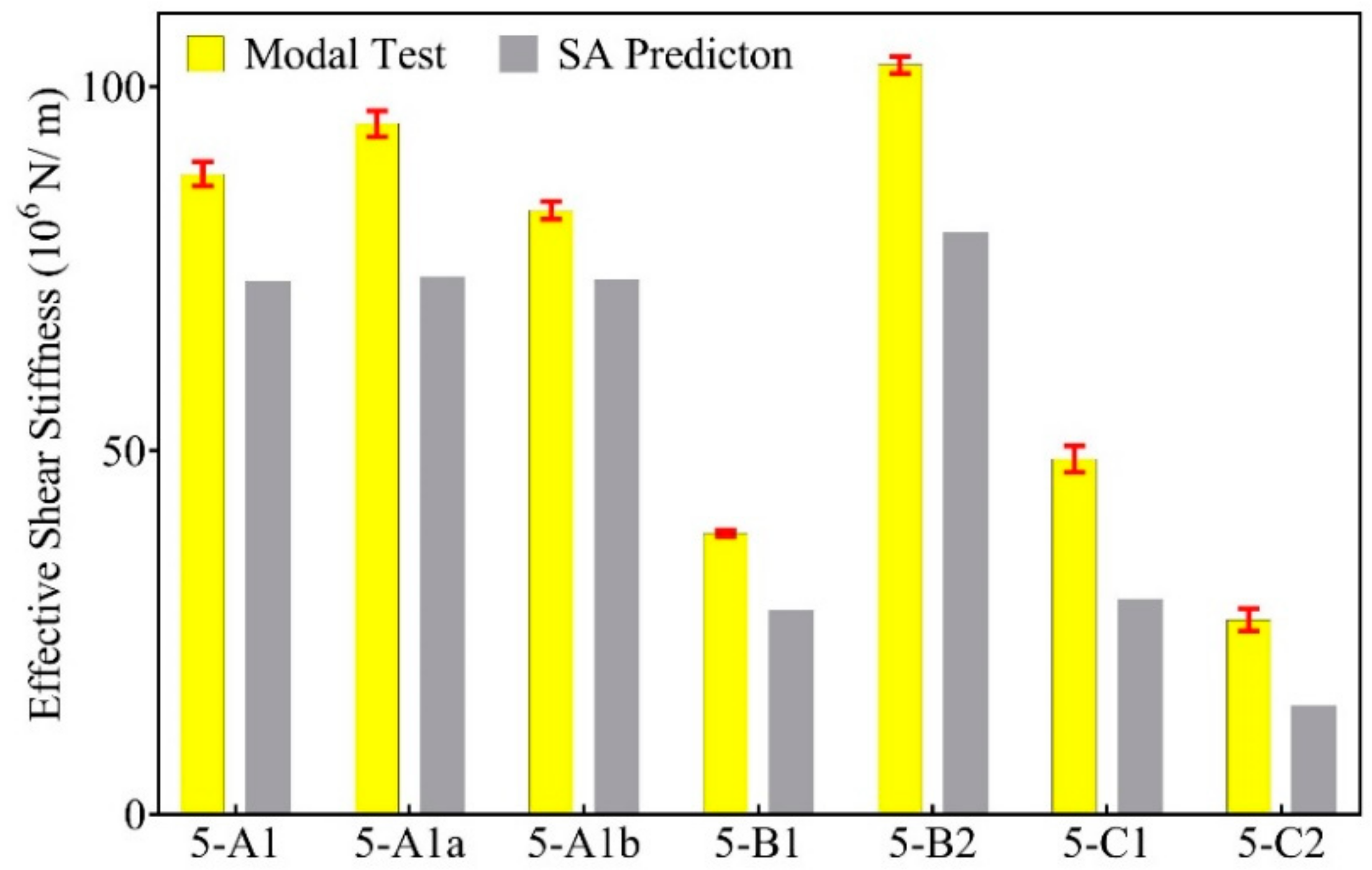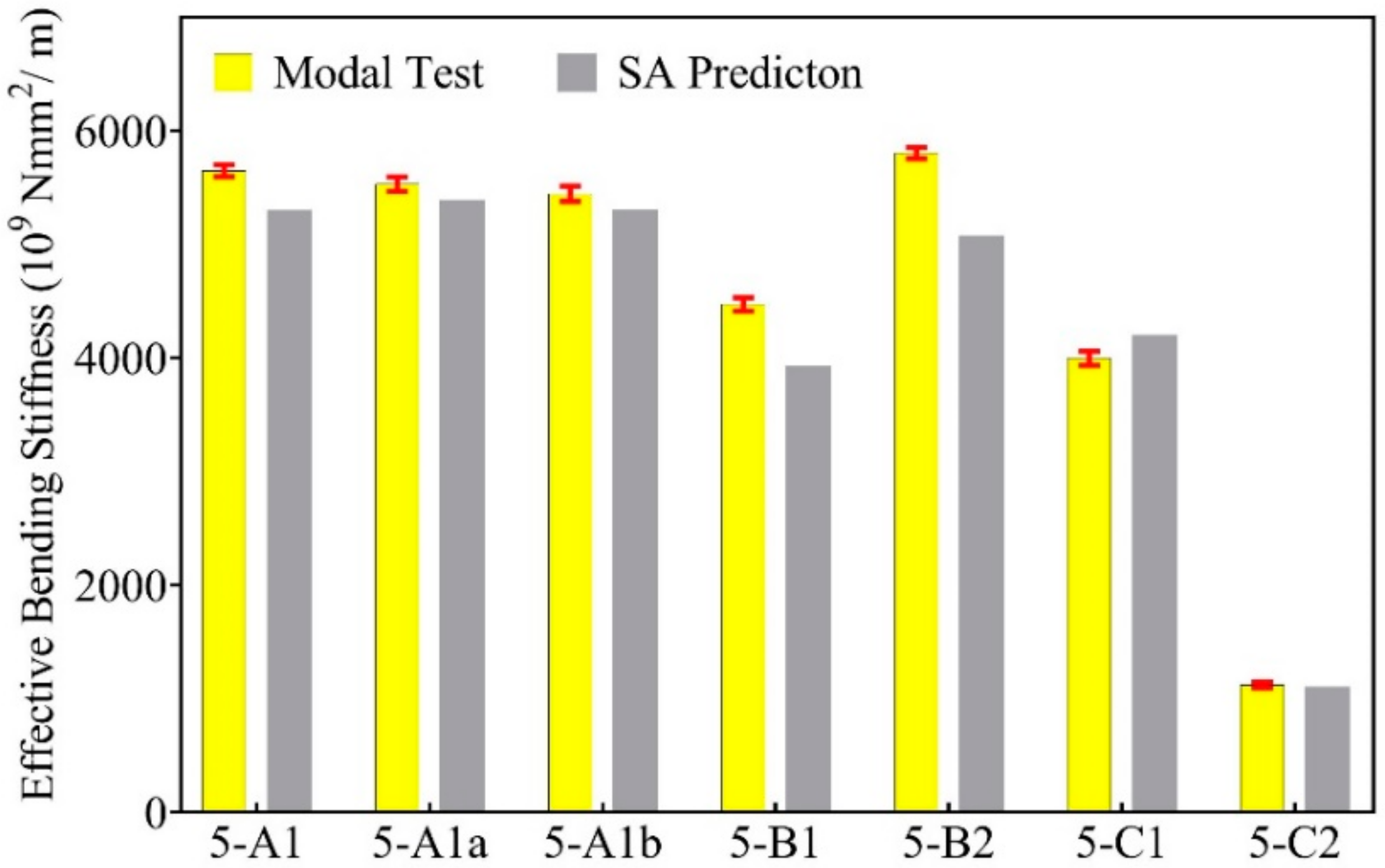Mechanical Properties of Innovative, Multi-Layer Composite Laminated Panels
Abstract
:1. Introduction
2. Materials and Methods
2.1. Materials
2.2. Component Tests
2.3. Panel Manufacturing
2.4. Modal Tests
2.5. Static Tests
2.5.1. Short-Span Shear Tests
2.5.2. Third-Point Bending Tests
2.6. Shear Analogy Method
3. Results and Discussion
3.1. Shear Properties
3.2. Bending Properties
3.3. Effect of Layup and Butt Joint on the Mechanical Properties of CLP
4. Conclusions
- (1)
- The use of LSL as transverse layers in CLP can eliminate the typical rolling shear failure of CLT and increase shear resistance and stiffness, bending moment resistance, and stiffness compared with generic CLT.
- (2)
- The CLP with LSL and lumber being parallel to grain in all layers performs the best among all the CLP lay-ups investigated in this study.
- (3)
- The shear analogy method can be used to predict the mechanical performance of CLP including stresses at failure, effective bending and shear stiffness, and apparent bending stiffness. However, the prediction of moment resistance depends on actual failure mode and the related material strength values.
- (4)
- Modal test is effective in measuring the bending and shear stiffness of MTP with a good agreement with static test results.
Author Contributions
Funding
Acknowledgments
Conflicts of Interest
References
- Brandner, R.; Flatscher, G.; Ringhofer, A.; Schickhofer, G.; Thiel, A. Cross laminated timber (CLT): Overview and development. Eur. J. Wood Wood Prod. 2016, 74, 331–351. [Google Scholar] [CrossRef]
- Zhou, J.; Chui, Y.H.; Gong, M.; Hu, L. Elastic properties of full-size mass timber panels: Characterization using modal testing and comparison with model predictions. Compos. Part B Eng. 2017, 112, 203–212. [Google Scholar] [CrossRef]
- Brandner, R.; Dietsch, P.; Dröscher, J.; Schulte-Wrede, M.; Kreuzinger, H.; Sieder, M. Cross laminated timber (CLT) diaphragms under shear: Test configuration, properties and design. Constr. Build. Mater. 2017, 147, 312–327. [Google Scholar] [CrossRef]
- APA—The Engineered Wood Association. Standard for Performance-Rated Cross-Laminated Timber; ANSI/APA PRG 320; APA—The Engineered Wood Association: Tocama, WA, USA, 2018. [Google Scholar]
- Wang, Z.; Gong, M.; Chui, Y.H. Mechanical properties of laminated strand lumber and hybrid cross-laminated timber. Constr. Build. Mater. 2015, 101, 622–627. [Google Scholar] [CrossRef]
- Davids, W.G.; Willey, N.; Lopez-Anido, R.; Shaler, S.; Gardner, D.; Edgar, R.; Tajvidi, M. Structural performance of hybrid SPFs-LSL cross-laminated timber panels. Constr. Build. Mater. 2017, 149, 156–163. [Google Scholar] [CrossRef]
- Chui, Y.H.; Gong, M.; Niederwestberg, J. Development of a Lumber-SCL Massive Timber Panel Product; Final Report #: WSTC2014-038; Wood Science and Technology Centre, The University of New Brunswick: Fredericton, NB, Canada, 2015. [Google Scholar]
- Zhou, J.; Niederwestberg, J.; Chui, Y.H. Development and Evaluation of 5-Layer Lumber-SCL Massive Timber Panel; Final Report; The University of Alberta: Edmonton, AB, Canada, 2017. [Google Scholar]
- ASTM. Standard Test Methods of Static Tests of Lumber in Structural Sizes; ASTM D198; ASTM International: West Conshohocken, PA, USA, 2010. [Google Scholar]
- ASTM. Standard Test Methods for Structural Panels in Planar Shear (Rolling Shear); ASTM D2718; ASTM International: West Conshohocken, PA, USA, 2006. [Google Scholar]
- Chui, Y.H.; Gong, M. Evaluation of Planar Shear Properties of Cross Layer in Massive Timber Panel; Final Report #: WSTC2013-015; Wood Science and Technology Centre, The University of New Brunswick: Fredericton, NB, Canada, 2015. [Google Scholar]
- Yee, H.W. Shear Strength of Canadian Softwood Structural Lumber. Master’s Thesis, The University of British Columbia, Vancouver, BC, Canada, 1995. [Google Scholar]
- Inman, D.J. Engineering Vibration, 4th ed.; Prentice Hall: Upper Saddle River, NJ, USA, 2008; pp. 538–540. ISBN 978-0-13-287169-3. [Google Scholar]
- Chui, Y.H. Simultaneous Evaluation of Bending and Shear Moduli of Wood and the Influence of Knots on these Parameters. Wood Fibre Sci. 1991, 25, 125–134. [Google Scholar] [CrossRef]
- Bogensperger, T.; Silly, G.; Schickhofer, G. Methodenvergleich Approximativer Nachweisverfahren für Brettsperrholz; Report #: MMSM 2.2.3 sfem_mat; Holz.Bau Forschungs GmbH, Institut für Holzbau und Holztechnologie, Technische Universität Graz: Graz, Austria, 2012. [Google Scholar]
- CSA. Engineering Design in Wood; CSA O86-14; CSA Group: Mississauga, ON, Canada, 2016. [Google Scholar]
- Forest Product Laboratory. Wood Handbook—Wood as an Engineering Material, Centennial ed.; Forest Products Laboratory: Madison, WI, USA, 2010; p. 182. [Google Scholar]












| Material | Index | MC (%) | Density (kg/m3) | MOE (MPa) | MOR (MPa) | Shear Modulus (MPa) | Shear Strength (MPa) | UTS (N/mm2) | |||
|---|---|---|---|---|---|---|---|---|---|---|---|
| // | ⊥ | // | // | ⊥ | // | ⊥ | // | ||||
| Lumber | Count | 18 | 18 | 38 | 38 | 6 | |||||
| Mean | 7.4 | 470 | 10,494 | 343 2 | 57.4 | 656 3 | 120 4 | 5 4 | 1.5 5 | 30.2 | |
| COV 1 | 3.1% | 6.4% | 15.5% | 23.9% | 20.1% | ||||||
| LSL | Count | 22 | 22 | 46 | 46 | 6 | 6 | 6 | 6 | 6 | |
| Mean | 3.4 | 644 | 9520 | 41.7 | 462 | 201 | 3.2 | 2.1 | 36.5 | ||
| COV 1 | 4.7% | 6.4% | 5.9% | 13.1% | 14.2% | 9.3% | 9.2% | 7.5% | 11.6% | ||
| Group ID | Layup | Orientation | Number of Panels | Bending Specimens | Shear Specimens | ||
|---|---|---|---|---|---|---|---|
| Dimension | Count | Dimension | Count | ||||
| 5-A1 | T-L-L-L-T | //-//-//-//-// | 3 | 2743 mm (length) × 195 mm (width) × 184 mm (thickness) | 13 | 1200 mm (length) × 195 mm (width) × 184 mm (thickness) | 8 |
| 5-A1a | T-L *-L-L *-T | //-// *-//-// *-// | 4 | 16 | 8 | ||
| 5-A1b | T-L-L *-L-T | //-//-// *-//-// | 4 | 14 | 8 | ||
| 5-B1 | L-T-L-T-L | //-⊥-//-⊥-// | 3 | 12 | 6 | ||
| 5-B2 | L-T-L-T-L | //-//-//-//-// | 3 | 14 | 6 | ||
| 5-C1 | T-T-T-T-T | //-⊥-//-⊥-// | 1 | 4 | 2 | ||
| 5-C2 | T-T-T-T-T | ⊥-//-⊥-//-⊥ | 1 | 4 | 2 | ||
| Group | Shear Resistance (kN/m) | Shear Stress at Failure (MPa) | Shear Stiffness (106 N/m) | Failure Mode | ||
|---|---|---|---|---|---|---|
| 5-A1 | 351.4 | 392.5 | 2.9 | 88.0 | 73.2 | Interfacial Shear |
| (5.7%) | (7.0%) | |||||
| 5-A1a | 342.0 | 393.0 | 2.8 | 94.9 | 73.7 | Interfacial Shear |
| (8.7%) | (7.5%) | |||||
| 5-A1b | 377.7 | 392.6 | 3.1 | 83.0 | 73.3 | Interfacial Shear |
| (4.3%) | (5.5%) | |||||
| 5-B1 | 195.7 | 224.0 | 1.4 | 38.6 | 28.0 | Rolling Shear |
| (4.7%) | (3.7%) | |||||
| 5-B2 | 446.2 | 384.3 | 3.6 | 103.0 | 79.9 | Interfacial Shear |
| (2.2%) | (4.3%) | |||||
| 5-C1 | 184.8 | 223.1 | 1.3 | 48.8 | 29.5 | Rolling Shear |
| (0.9%) | (7.3%) | |||||
| 5-C2 | 93.9 | 117.7 | 1.2 | 26.7 | 14.8 | Rolling Shear |
| (0.5%) | (11.5%) | |||||
| Group | Moment Resistance (kNm/m) | Bending Stiffness (109 Nmm2/m) | Failure Mode | |||||
|---|---|---|---|---|---|---|---|---|
| 5-A1 | 181 | 309 | 4871 | 5053 | 4773 | 5650 | 5292 | Tension |
| (10.3%) | (3.1%) | (3.2%) | (3.3%) | |||||
| 5-A1a | 158 | 313 | 4688 | 4985 | 4854 | 5531 | 5388 | Tension |
| (15.2%) | (5.0%) | (3.8%) | (4.6%) | |||||
| 5-A1b | 166 | 309 | 4655 | 4861 | 4781 | 5446 | 5301 | Tension |
| (19.3%) | (3.6%) | (4.4%) | (4.6%) | |||||
| 5-B1 | 117 | 194 | 3477 | 3721 | 3242 | 4473 | 3927 | Rolling shear |
| (10.2%) | (4.1%) | (3.7%) | (4.5%) | |||||
| 5-B2 | 226 | 250 | 5008 | 5247 | 4629 | 5804 | 5071 | Tension |
| (5.5%) | (3.4%) | (3.2%) | (3.2%) | |||||
| 5-C1 | 121 | 247 | 3511 | 3499 | 3456 | 3998 | 4195 | Rolling shear |
| (3.3%) | (3.2%) | (2.3%) | (3.1%) | |||||
| 5-C2 | 60 | 108 | 964 | 1038 | 988 | 1123 | 1098 | Rolling shear |
| (2.4%) | (3.7%) | (3.8%) | (4.7%) | |||||
© 2018 by the authors. Licensee MDPI, Basel, Switzerland. This article is an open access article distributed under the terms and conditions of the Creative Commons Attribution (CC BY) license (http://creativecommons.org/licenses/by/4.0/).
Share and Cite
Niederwestberg, J.; Zhou, J.; Chui, Y.-H. Mechanical Properties of Innovative, Multi-Layer Composite Laminated Panels. Buildings 2018, 8, 142. https://doi.org/10.3390/buildings8100142
Niederwestberg J, Zhou J, Chui Y-H. Mechanical Properties of Innovative, Multi-Layer Composite Laminated Panels. Buildings. 2018; 8(10):142. https://doi.org/10.3390/buildings8100142
Chicago/Turabian StyleNiederwestberg, Jan, Jianhui Zhou, and Ying-Hei Chui. 2018. "Mechanical Properties of Innovative, Multi-Layer Composite Laminated Panels" Buildings 8, no. 10: 142. https://doi.org/10.3390/buildings8100142
APA StyleNiederwestberg, J., Zhou, J., & Chui, Y.-H. (2018). Mechanical Properties of Innovative, Multi-Layer Composite Laminated Panels. Buildings, 8(10), 142. https://doi.org/10.3390/buildings8100142






